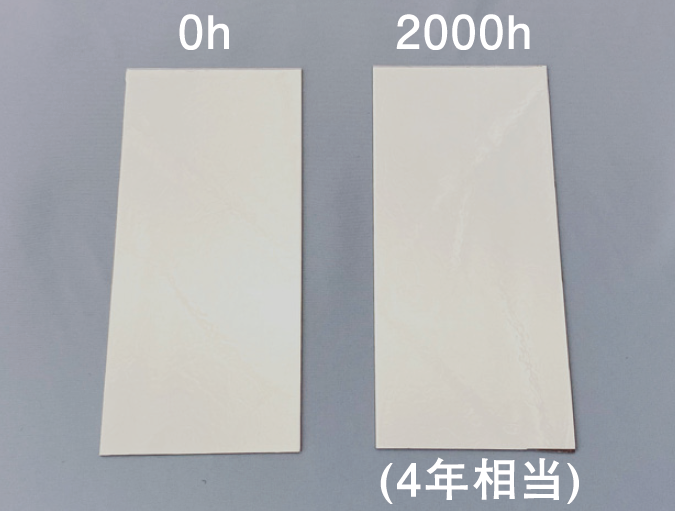Materials development
SPACECOOL® (New Zero-power Cooling Material Releasing Heat into Space Even under the Scorching Sun)
Overview
Osaka Gas has developed a new material (radiative sky cooling material) that features the property of cooling down in direct sunlight to a lower temperature than the ambient temperature without using energy by allowing heat to escape to space, whose temperature is –270℃ (radiative cooling).
Background
Radiative cooling is a phenomenon in which heat is emitted from the Earth into space in the form of light called thermal radiation. It is a well-known phenomenon that drops the temperature at night. Radiative cooling occurs during the day as well as at night, but since the incoming heat energy of the sunlight is much larger than the radiant energy attributed to thermal radiation, the sunlight irradiates general materials such as metals and concrete and causes the material temperature to rise above the ambient temperature.
Osaka Gas has successfully developed SPACECOOL®, which is a radiative sky cooling material designed to cool down in direct sunlight to a lower temperature than the ambient temperature without using energy. This has been achieved by using Osaka Gas’s optical control technology to develop a material design that reduces the solar heat input while increasing heat dissipation through thermal radiation.

Principle of SPACECOOL®
By suppressing the absorption of radiation from sunlight and from the atmosphere and increasing the release of heat into space through thermal radiation, the temperature goes down below the ambient temperature even under direct sunlight.
Feature 1. Cooling under the scorching sun
We conducted testing at one of our research laboratories during the summer (June to September). The test results showed that in direct sunlight the cooling performance was a maximum decrease of 6℃ compared to the ambient temperature.

Temperature comparison of SPACECOOL® and solar reflective paint under the hot summer sun
Feature 2. High durability
An accelerated test confirmed that it has UV weather resistance (durability when installed outdoors) for ten years or more. We have confirmed that no discoloration or spectral change occurred.

Xenon weather test results
Feature 3. Formed into a sheet
Two types of forms are available: flexible and easy-to-use adhesive film and strong and flexible canvas.

Product appearance
Application Example
The results of a demonstration test using warehouses and another demonstration test using helmets are illustrated below.
Results of SPACECOOL®Results of SPACECOOL® demonstration tests
Future Deployment
SPACECOOL Inc., which is jointly operated by the venture capital WiL, based both in Japan and the United States, and Osaka Gas, conducts marketing activities, manufactures, and distributes the radiative sky cooling material.
Having been adopted as one of the “demonstration experiments on Yumeshima” organized by the Japan Association for the 2025 World Exposition and the Osaka Chamber of Commerce and Industry, a demonstration experiment (Osaka Gas being the representative legal person) was launched on August 26, 2021 at the planned Expo site on Yumeshima and at other sites to evaluate the energy-saving performance, comfort and other properties of the radiative sky cooling material SPACECOOL. We will utilize the findings gained from the demonstration to help achieve low-carbonization or decarbonization and comfortable spaces for society as a whole.
Through alliances with various companies, SPACECOOL will offer the value of safety and comfort for people, such as preventing heatstroke and keeping the freshness of food, the value of economy for goods, such as improving reliability (including reduction of failure of outdoor equipment) and space efficiency and reducing costs, and the value of reducing greenhouse gas emissions and improving the environmental performance for society by means of zero-power cooling.

Company logo

Application example
Related contents
TAG SEARCH
- Evolving residential gas appliances
- Evolving residential gas appliances Water heaters, space heaters, dryers Cooking appliances Smart Equipment Fuel Cell systems
- Evolving commercial and industrial gas appliances
- Evolving commercial and industrial gas appliances Cogeneration (CHP) units Air conditioning systems, kitchen appliances Bio, water treatment Industrial furnaces, burners Energy management, IoT
- Enhancing the safety and economic efficiency of LNG regasification
- Enhancing the safety and economic efficiency of LNG regasification Utilization of cold energy Plant materials Power generation technology
- Developing next-generation businesses through enterprising initiatives
- Developing next-generation businesses through enterprising initiatives Materials development Measurement Simulation, data analysis Food science Material evaluation
- Contributing to conserving the environment and achieving a carbon neutral society
- Contributing to conserving the environment and achieving a carbon neutral society Methanation Hydrogen, ammonia Biogas Energy management Renewable Energy
- Technologies of Group companies
- KRI, Inc. Osaka Gas Chemicals Group OGIS-RI Group



